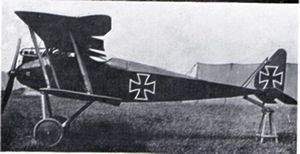Halberstadt D.II
| Halberstadt D.II | |
|---|---|
 |
|
| Halberstadt D.II painted in a dark colour - allegedly flown by Boelcke | |
| Role | Fighter |
| Manufacturer | Halberstädter Flugzeugwerke |
| Designer | Karl Theis |
| First flight | Late 1915 |
| Introduction | Early 1916 |
| Retired | 1917 |
| Primary user | Luftstreitkräfte |
| Produced | 1916 |
| Number built | 65 |
The Halberstadt D.II was a biplane fighter aircraft of the Luftstreitkräfte (Imperial German Army Air Service) that served through the period of Allied air superiority in early 1916. As the first biplane configuration fighter aircraft to serve in combat for the German Empire, it had begun to be superseded in the Jagdstaffeln and other early German fighter units by the superior Albatros fighters in the second half of the year, although small numbers of Halberstadts continued in use well into 1917.
The D.II was the production version of the experimental D.I. Lightened to improve performance, it also featured staggered wings and a more powerful 120 hp Mercedes D.II engine. The side and frontal radiators that had been tried in the D.I were replaced by a wing mounted radiator, similar to that later used by the Albatros D.III and D.V. The two bay wings were very strongly braced, with the trailing edge a wooden member, as opposed to the wire or cable common on many World War I German single-engined aircraft. Photographic evidence indicates that many examples were rigged with washout on the lower wings – giving the impression of a curved or twisted lower wing trailing edge. In some photos even the upper wings have a similar sort of "trailing edge droop" on the fixed section inboard of the ailerons.
In comparison with the D.I, the pilot sat higher in his cockpit, to improve his view over the top wing. This required a dorsal turtleback fairing over the rear fuselage, to improve its lines.
Lateral control was by ailerons, but the Morane-style empennage (common not only to Moranes, but also to the Fokker and Pfalz types of the period) was retained. The inevitable result was extreme fore-and-aft sensitivity and poor control harmonization. The D.II was nonetheless considered to be very manoeuvrable in skilled hands: in particular it could reputedly be dived safely at high speed. A single synchronised "Spandau" machine gun fired through the propeller arc.
...
Wikipedia
